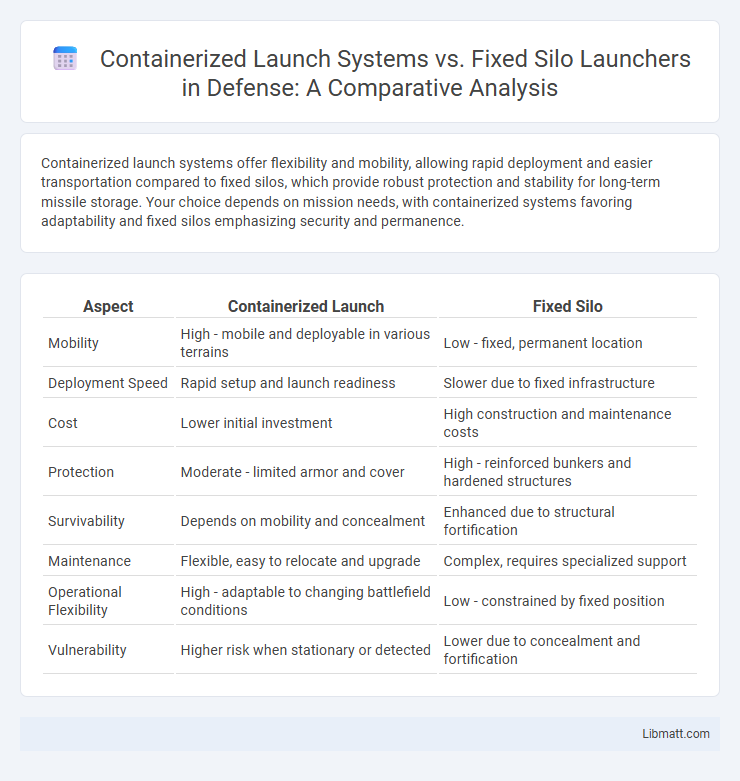Containerized launch systems offer flexibility and mobility, allowing rapid deployment and easier transportation compared to fixed silos, which provide robust protection and stability for long-term missile storage. Your choice depends on mission needs, with containerized systems favoring adaptability and fixed silos emphasizing security and permanence.
Table of Comparison
| Aspect | Containerized Launch | Fixed Silo |
|---|---|---|
| Mobility | High - mobile and deployable in various terrains | Low - fixed, permanent location |
| Deployment Speed | Rapid setup and launch readiness | Slower due to fixed infrastructure |
| Cost | Lower initial investment | High construction and maintenance costs |
| Protection | Moderate - limited armor and cover | High - reinforced bunkers and hardened structures |
| Survivability | Depends on mobility and concealment | Enhanced due to structural fortification |
| Maintenance | Flexible, easy to relocate and upgrade | Complex, requires specialized support |
| Operational Flexibility | High - adaptable to changing battlefield conditions | Low - constrained by fixed position |
| Vulnerability | Higher risk when stationary or detected | Lower due to concealment and fortification |
Introduction to Containerized Launch and Fixed Silo Systems
Containerized launch systems offer modular, pre-assembled solutions that enhance mobility and rapid deployment for rocket launches, contrasting with fixed silo systems designed for permanent, heavily fortified launch sites offering maximum protection and stability. You benefit from containerized systems through their flexibility in location and reduced setup time, while fixed silos provide superior environmental shielding and launch readiness for strategic and long-term missions. Both systems leverage advanced engineering for rocket storage, fueling, and launch control, with choice depending on mission requirements and operational priorities.
Core Differences Between Containerized Launch and Fixed Silo Approaches
Containerized launch systems house rockets within mobile, sealed containers that provide environmental protection and streamlined transport, enabling rapid deployment and flexible launch site selection. Fixed silo approaches involve permanently constructed underground facilities offering enhanced structural protection and stability, suited for long-term defense readiness. Containerized systems prioritize mobility and operational adaptability, whereas fixed silos emphasize durability and fortified security.
Historical Evolution of Missile Launch Platforms
Missile launch platforms have evolved from fixed silos, first developed in the Cold War era for enhanced protection and rapid launch capability, to containerized launch systems offering improved mobility and stealth. Fixed silos provided robust defense against attacks but were limited by their immobility and vulnerability to targeted strikes. Containerized launch platforms utilize modular transport containers that allow missile deployment from diverse locations, increasing strategic flexibility and survivability in modern warfare scenarios.
Key Components of Containerized Launch Systems
Containerized launch systems integrate modular components such as transportable payload fairings, universal mounting platforms, and flexible fueling interfaces, enabling rapid deployment and scalability for diverse missions. Key elements include self-contained environmental control units, standardized electrical and data connectors, and lightweight thermal insulation to ensure payload safety during transit and launch. This modularity contrasts with fixed silo systems by offering enhanced adaptability, reduced infrastructure costs, and accelerated launch cadence.
Fixed Silo: Design and Operational Principles
Fixed silo design emphasizes durability and long-term storage efficiency, using reinforced materials suited for heavy loads and environmental resistance. Operational principles focus on gravity-fed unloading, airtight sealing to prevent contamination, and consistent monitoring of moisture levels to preserve stored materials. Understanding these features helps you optimize storage solutions for bulk goods with reliable, minimal maintenance needs.
Mobility and Deployability: A Comparative Analysis
Containerized launch systems offer superior mobility and deployability compared to fixed silos, enabling rapid relocation and flexible strategic positioning across diverse terrains. Fixed silos provide robust, hardened protection but lack the ability to be moved once constructed, limiting their operational adaptability. Your choice depends on whether you prioritize dynamic deployment capabilities or permanent, heavily fortified infrastructure.
Survivability and Security Considerations
Containerized launches offer enhanced survivability compared to fixed silos due to their mobility and ability to be rapidly deployed, reducing the risk of detection and targeted strikes. Fixed silos provide robust physical protection with hardened structures and underground bunkers, but their fixed locations make them vulnerable to preemptive attacks. Security considerations prioritize concealment and redundancy in containerized systems, while fixed silos rely on formidable structural defense and continuous monitoring to deter and withstand assaults.
Cost Efficiency and Maintenance Requirements
Containerized launches offer superior cost efficiency due to their modular design, enabling rapid deployment and reduced setup time compared to fixed silos. Maintenance requirements for containerized systems are generally lower, as their mobility allows for easier access and replacement of components without extensive structural disruption. Fixed silos incur higher long-term costs owing to rigid infrastructure, complex maintenance procedures, and limited adaptability to technological upgrades.
Strategic Advantages and Limitations
Containerized launch systems offer operational flexibility, rapid deployment, and modular scalability, making them ideal for varying mission requirements and geographic locations. Fixed silos provide robust protection and hardened defense capabilities, ensuring missile readiness and deterrence through secure, underground facilities. However, containerized systems may face challenges in long-term durability and vulnerability to environmental factors, while fixed silos suffer from high construction costs and limited relocation options, impacting strategic adaptability.
Future Trends in Missile Launch Platform Development
Future trends in missile launch platform development emphasize the shift from fixed silo installations to containerized launch systems, driven by the need for enhanced mobility and rapid deployment capabilities. Containerized launch platforms offer increased strategic flexibility, enabling operators to deploy missile systems from various environments while reducing detectability and vulnerability. Advances in modular design and automated launch technologies further support the integration of containerized systems, positioning them as a key component in modern and adaptable missile defense strategies.
containerized launch vs fixed silo Infographic

 libmatt.com
libmatt.com